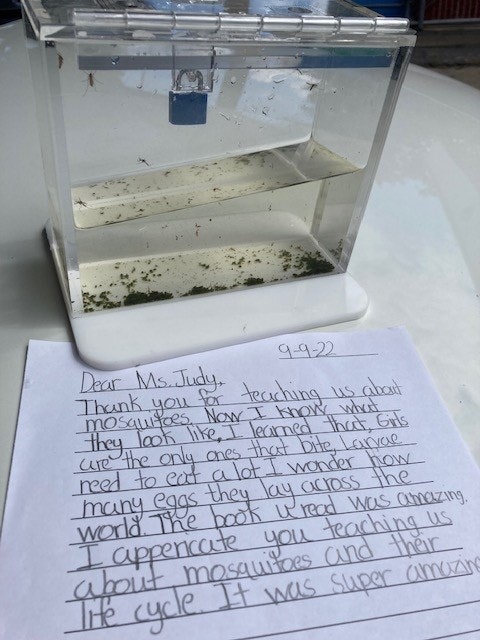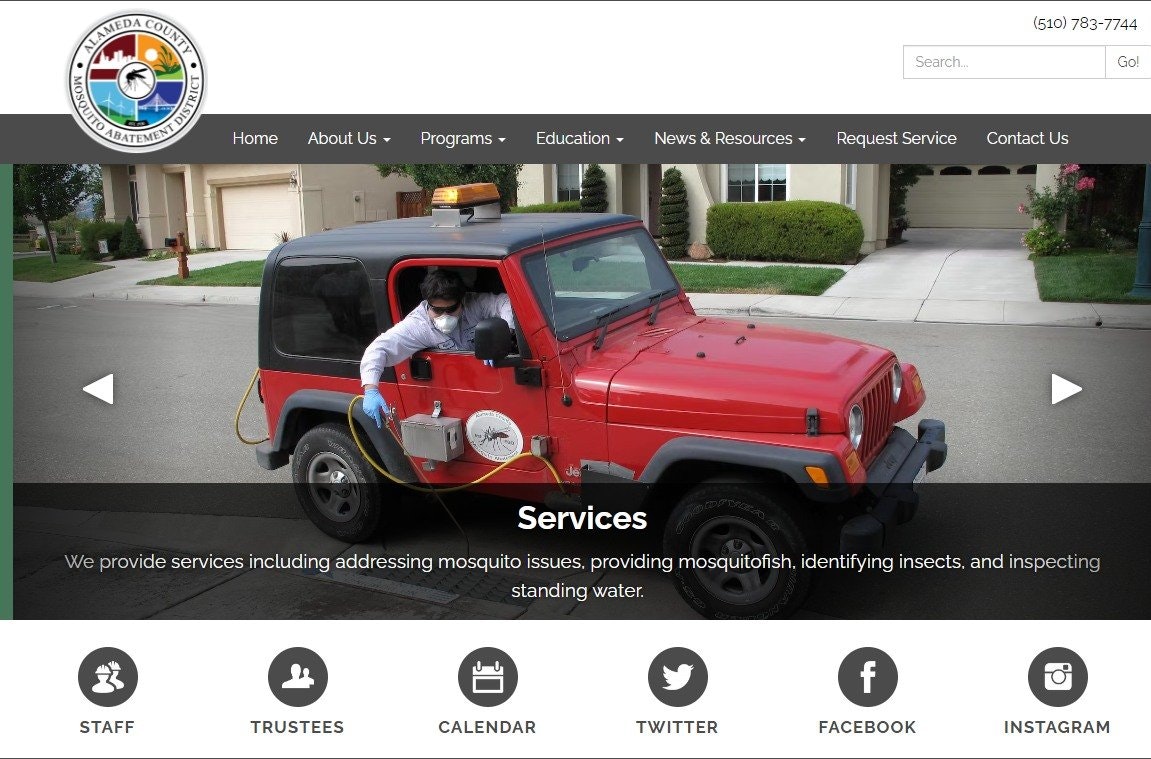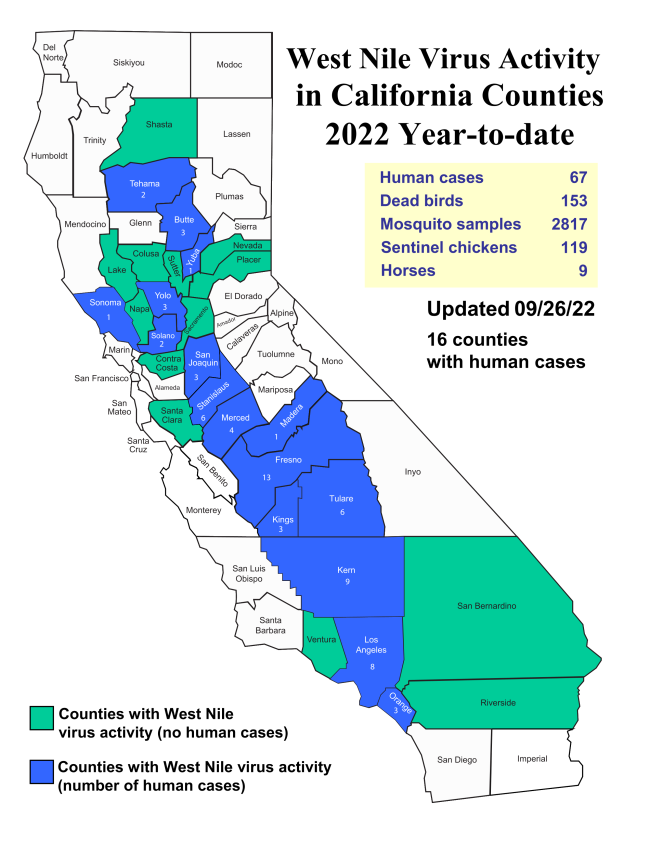Fall Newsletter 2022
Fall 2022
Quarterly Newsletter and Updates
Invasive Aedes- be on the lookout!
We are on high alert for Aedes aegypti mosquitoes in Alameda County. Aedes aegypti are an invasive mosquito, meaning they are not native to the region. They have been making their way from southern to northern California for years, and they are currently found in a few neighboring counties, as you can see from the most recent California Department of Public Health Aedes Distribution Map. These mosquitoes are incredibly adept at hiding their eggs in containers of all sizes. Everything from the inside of a forgotten tire to a tossed bottlecap can hold enough water to produce these aggressive mosquitoes. They are known for biting during daylight hours, and often attack the lower parts of the human body, such as the ankles and legs. The real threat of Aedes aegypti is not their irksome bite, but what it can contain. Aedes aegypti is capable of transmitting pathogens we are not accustomed to in Alameda County, such as Zika virus, yellow fever, chikungunya, and dengue. Given how difficult it is to find their eggs, and how severe the potential diseases can be for residents, we encourage residents to be extra observant if they are experiencing mosquitoes in their homes, workplaces, and beyond. If you find a mosquito biting during the day, quickly slap it, and without dragging or smearing, place it on a piece of tape, in an envelope, or another item to preserve the body. Give us a call immediately and we will identify the species of mosquito. Public awareness is vital to ensure these invasive mosquitoes do not become a part of our normal way of life in Alameda County.

Student Intern Projects

During the summer we hire interns in the lab to help assess mosquito abundance in the county and to conduct research. These interns take on a variety of routine tasks such as trapping and identifying mosquitoes, with much of their time reserved for developing unique research projects. This year our two interns worked on projects which seek to decrease labor-intensive species identification and detection work that can often burden mosquito abatement organizations. When we develop technologies to make mosquito identification and monitoring more efficient, we share these technologies with other mosquito districts, particularly those with lower resources. Sharing knowledge and new technologies with other organizations is just one way we contribute to mosquito control beyond Alameda County. Learn more about the challenges of mosquito monitoring and our interns contributions below!
Mosquito traps are routinely placed by control professionals to determine the mosquito species in an area. This is a crucial component of mosquito control programs because while all mosquitoes aggravate people with their bites, only a few species can spread life-threatening diseases to people. Determining the species of mosquitoes that are collected in traps requires time and expert knowledge, both of which can be limited in under-resourced mosquito control organizations. The research project that was led by Anam Safoora, a rising senior at UC Davis, is using artificial intelligence (AI) to automate mosquito identification. She photographed thousands of mosquitoes in the lab using a cell phone camera and noted the species of each mosquito in the images. Those images are being used by our collaborators at CZ Biohub, a nonprofit scientific research organization, to train an AI system that will automatically identify the mosquitoes in the photographs. The long-term goal is to develop software that can be loaded on any cell phone, which can enable mosquito control professionals to quickly identify mosquitoes and determine the risk of mosquito borne disease to a community.
Mosquitoes of a particular species are typically tied to specific ecosystems. To locate ecosystems that can support mosquito reproduction, mosquito control professionals drive vehicles to sites in question, place traps, and identify the mosquitoes that are collected. Andrew Burns, a rising senior at UC Berkeley, is developing an AI system that uses satellite imagery to automatically determine the ecosystem on the ground and the species of mosquitoes that are likely to be present. His goal is to enable mosquito control professionals to improve the efficiency and equity of services they provide by helping them better understand where their resources should be deployed to have the greatest impact.
We thank Andrew and Anam for their dedication and creative mindset over the summer in developing these research projects and their excellence in supporting our mosquito monitoring programs.
Mosquito Life Cycle Curriculum is Live

We are offering free lessons on the mosquito life cycle to 3rd grade students in Alameda County. The curriculum is standards aligned and can be customized to the needs of the teacher. Students learn about the life cycle and raise mosquitoes in a locked container. We have had great feedback about the curriculum from teachers in San Leandro and Newark, and we want to expand it further. If you are interested, please email our Public Outreach Coordinator, Judith Pierce at judith@mosquitoes.org.
Social Media Moment

Have you seen one of our Jeeps with the wheel on the right side rolling by your street? Ever wondered what exactly they do? They're controlling mosquito populations in sewers and catch basins! Learn more at our website, http://mosquitoes.org
Announcements: New hire and a new paper
New Assistant Mosquito Control Technician: Pamela Wilde
We have hired a hired a new Assistant Mosquito Control Technician, Pamela Wilde. She recently spent the summer with our team as a seasonal employee, focused on treating catch basins throughout the county and assisting with tidal marsh treatments. In this permanent role, Pamela will oversee parts of San Leandro, Hayward, and Union City. Pamela is also completing her degree at Cal State East Bay.
New Publication
Eric Haas-Stapleton along with a team that includes numerous ACMAD employees, has published another paper, entitled “Quantitative reverse transcription PCR assay to detect a genetic marker of pyrethroid resistance in Culex mosquitoes.” Congratulations to Eric and the team.
Public Events for Fall 2022*
October 8 Don Edwards 50th Anniversary in Fremont
October 15 Diwali Festival in Fremont
October 29 Quest Science Center Presents: The Science of Halloween
*events are subject to change. Check our website for the most up to date information
West Nile Virus Location Update

While Alameda County has not detected West Nile virus so far this year, we have had infected birds as late as October in some years. As a best practice, our lab will test suitable dead birds for West Nile virus (WNV). If you come across a dead bird please report it online at www.westnile.ca.gov. Mosquitoes enjoy periods of rain followed by sunshine, which the county has experienced recently. Preventative activities such as removing standing water, adding mosquito fish to ponds, troughs, and neglected swimming pools, reduce our risk of West Nile virus. Now is a great time to check for standing water in your yard and drain or cover anything that will hold water longer than 4 days. Visit our backyard checklist to see common places where mosquitoes produce.
